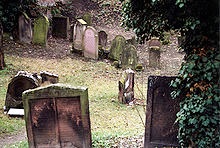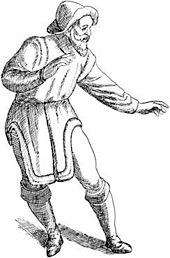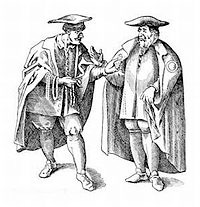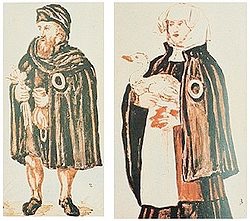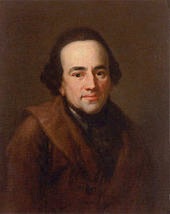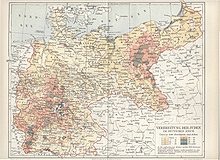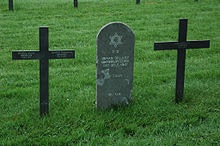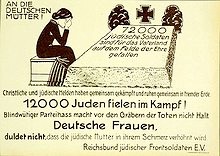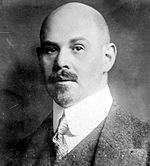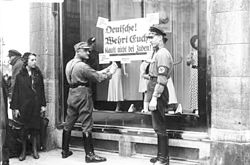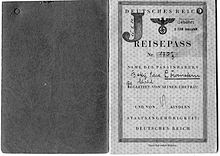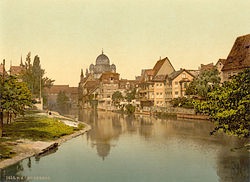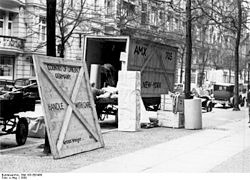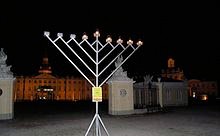Berlin, Germany
History of the Jews in Germany

From Wikipedia, the free encyclopedia
Notable German Jews
Total population
119,000[1]
Regions with significant populations
Languages
Religion
Related ethnic groups
other Ashkenazi Jews
Jewish settlers founded the Ashkenazi Jewish community in the Early (5th to 10th centuries CE) and High Middle Ages (c.1000-1299 CE). The community prospered under Charlemagne, but suffered during the Crusades. Accusations of well poisoning during the Black Death (1346–53) led to mass slaughter of German Jews,[2] and their fleeing in large numbers to Poland. The Jewish communities of the cities of Mainz, Speyer and Worms became the center of Jewish life during Medieval times. "This was a golden age as area bishops protected the Jews resulting in increased trade and prosperity."[3] The First Crusade began an era of persecution of Jews in Germany[citation needed]. Entire communities, like those of Trier, Worms, Mainz, and Cologne, were murdered. During the war upon the Hussite heretics became the signal for the slaughter of the unbelievers. The end of the 15th century was a period of religious hatred that ascribed to Jews all possible evils. The atrocities of Chmielnicki (1648, in the Ukrainian part of southeastern Poland) and his Cossacks drove the Polish Jews back into western Germany. With Napoleon's fall in 1815, growing nationalism resulted in increasing repression. From August to October 1819, pogroms that came to be known as the Hep-Hep riots took place throughout Germany. During this time, many German states stripped Jews of their civil rights. As a result, many German Jews began to emigrate.
From the time of Moses Mendelssohn until the 20th century the community gradually achieved emancipation, and then prospered. In January 1933, some 522,000 Jews lived in Germany. However, following the growth of Nazism and its antisemitic ideology and policies, the Jewish community was severely persecuted. Over half (approximately 304,000) emigrated during the first six years of the Nazi dictatorship. In 1933, persecution of the Jews became an active Nazi policy. In 1935 and 1936, the pace of persecution of the Jews increased. In 1936, Jews were banned from all professional jobs, effectively preventing them from exerting any influence in education, politics, higher education and industry. The SS ordered the Night of Broken Glass (Kristallnacht) to be carried out that night, November 9–10, 1938. The storefronts of Jewish shops and offices were smashed and vandalized, and many synagogues were destroyed by fire. Increasing antisemitism prompted a wave of a Jewish mass emigration from Germany throughout the 1930s. There were only approximately 214,000 Jews in Germany proper (1937 borders) on the eve of World War II.
The remaining community was nearly eradicated in the Holocaust following deportations to the East.[4] By the end of the war between 160,000 and 180,000 German Jews had been killed in the genocide officially sanctioned and executed by Nazi Germany.[4] In the Holocaust, approximately 6 million European Jews were deported and murdered during World War II. On May 19, 1943, Germany was declared judenrein (clean of Jews; also judenfrei: free of Jews). Of the 214,000 Jews still living in Germany at the outbreak of World War II, 90% died during the Holocaust.[4] After the war the Jewish community started to slowly grow again, fueled primarily by immigration from the former Soviet Union and Israeli expatriates. By the 21st century, the Jewish population of Germany approached 200,000, and Germany had the only growing Jewish community in Europe.[5]
Currently in Germany it is a criminal act to deny the Holocaust or that six million Jews were murdered in the Holocaust (§130 StGB); violations can be punished with up to five years of prison.[6] In 2007, the Interior Minister of Germany, Wolfgang Schäuble, pointed out the official policy of Germany: "We will not tolerate any form of extremism, xenophobia or anti-Semitism."[7] In spite of Germany's measures against right-wing groups and anti-Semites a number of incidents has occurred in recent years.
From Rome to the Crusades
Jews of Germany, 13th century
Jewish immigration from Roman Italy is considered the most likely source of the first German Jews. While the date of the first settlement of Jews in the regions the Romans called Germania Superior, Germania Inferior, and Magna Germania is not known, the first authentic document relating to a large and well-organized Jewish community in these regions dates from 321[8][9][10][11] and refers to Cologne on the Rhine.[12][13][14] (In Rome itself, a Jewish community existed as early as 139 BC.[15]) It indicates that the legal status of the Jews there was the same as elsewhere in the Roman Empire. They enjoyed some civil liberties, but were restricted regarding the dissemination of their faith, the keeping of Christian slaves, and the holding of office under the government.
Jews were otherwise free to follow any occupation open to their fellow citizens and were engaged in agriculture, trade, industry, and gradually money-lending. These conditions at first continued in the subsequently established Germanic kingdoms under the Burgundians and Franks, for ecclesiasticism took root slowly. The Merovingian rulers who succeeded to the Burgundian empire were devoid of fanaticism and gave scant support to the efforts of the Church to restrict the civic and social status of the Jews.
Charlemagne (800–814) readily made use of the Church for the purpose of infusing coherence into the loosely joined parts of his extensive empire, by any means a blind tool of the canonical law. He employed Jews for diplomatic purposes, sending, for instance, a Jew as interpreter and guide with his embassy to Harun al-Rashid. Yet, even then, a gradual change occurred in the lives of the Jews. The Church forbade Christians to be usurers, and so the Jews secured the remunerative monopoly of money-lending. This decree caused a mixed reaction of people in general in the Frankish empire (including Germany) to the Jews: Jewish people were sought everywhere as well as avoided. This ambivalence about Jews occurred because their capital was indispensable, while their business was viewed as disreputable. This curious combination of circumstances increased Jewish influence and Jews went about the country freely, settling also in the eastern portions. Aside from Cologne, the earliest communities were established in Mainz, Worms and Speyer, which existed up until the 1930s.
The status of the German Jews remained unchanged under Charlemagne's successor Louis the Pious. Jews were unrestricted in their commerce; however, they paid somewhat higher taxes into the state treasury than did the Christians. A special officer, the Judenmeister, was appointed by the government to protect Jewish privileges. The later Carolingians, however, followed the demands of the Church more and more. The bishops continually argued at the synods for including and enforcing anti-Semitic decrees of the canonical law, with the consequence that the majority Christian populace mistrusted the Jewish unbelievers. This feeling, among both princes and people, was further stimulated by the attacks on the civic equality of the Jews. Beginning with the 10th century, Holy Week became more and more a period of anti-Semitic activities. Yet the Saxon emperors did not treat the Jews badly, exacting from them merely the taxes levied upon all other merchants. Although they were as ignorant as their contemporaries in secular studies, they could read and understand the Hebrew prayers and the Bible in the original text. Halakhic studies began to flourish about 1000. At that time, Rav Gershom ben Judah was teaching at Metz and Mainz, gathering about him pupils from far and near. He is described in Jewish historiography as a model of wisdom, humility, and piety, and has been praised as a "lamp of the Exile". He first stimulated the German Jews to study the treasures of their religious literature.
This continuous study of the Torah and the Talmud produced such a devotion to Judaism that the Jews considered life without their religion not worth living; but they did not realize this clearly until the time of the Crusades, when they were often compelled to choose between life and faith.
Cultural and religious centre of European Jewry
The Jewish communities of the cities of Mainz, Speyer and Worms formed the league of ShUM-cities which became the center of Jewish life during Medieval times (after the first letters of the Hebrew names: Shin for Schpira (Spira), Waw for Warmaisa and Mem for Main). The Takkanot Shum (Hebrew: תקנות שו"ם), or Enactments of ShU"M were a set of decrees formulated and agreed upon over a period of decades by their Jewish community leaders. The official website for the city of Mainz states:
“
One of the most glorious epoches in Mainz's long history was the period from the beginning of the 900s and evidently much earlier. Following the barbaric Dark Ages, a relatively safe and enlightened Carolingian period brought peace and prosperity to Mainz and much of central–western Europe.
For the next 400 years, Mainz attracted many Jews as trade flourished. The greatest Jewish teachers and rabbis flocked to the Rhine. Their teachings, dialogues, decisions and influence propelled Mainz and neighboring towns along the Rhine into world-wide prominence. Their fame spread, rivaling that of other post-Diaspora cities such as Bagdhad. Western European— Ashkenazic or Germanic— Judaism became centered in Mainz, breaking free of the Babylonian traditions. A Yeshiva was founded in the 10th century by Gershom ben Judah.[3]”
According to historian John Man, "Mainz was the capital of European Jewry"; "it had its own Jewish academy for over 300 years"; "it was revered as the home of Gershom ben Judah, the 'Light of the Diaspora,' who in the eleventh century was the first to bring copies of the Talmud to Western Europe and whose directives helped Jews adapt to European practices. Gershom's school attracted Jews from all over Europe, including the famous biblical scholar Rashi; "[16] and "in the mid-fourteenth century, it had the largest Jewish community in Europe, some 6,000 citizens."[17]:16 "In essence," states the City of Mainz web site, "this was a golden age as area bishops protected the Jews resulting in increased trade and prosperity."[3]
A period of massacres (1096–1349)
Heiliger Sand, the Jewish Cemetery in Worms
The First Crusade began an era of persecution of Jews in Germany[citation needed]. Entire communities, like those of Trier, Worms, Mainz, and Cologne, were murdered. The Jewish community of Speyer was saved by the bishop, but 800 were slain in Worms. About 12,000 Jews are said to have perished in the Rhenish cities alone between May and July 1096. Alleged crimes, like desecration of the host, ritual murder, poisoning of wells, and treason, brought hundreds to the stake and drove thousands into exile. Jews were alleged to have caused the inroads of the Mongols, even though they suffered equally with the Christians. When the Black Death swept over Europe in 1348–49, some Christians communities accused Jews of poisoning wells. Royal policy and public ambivalence towards Jews helped the persecuted Jews fleeing the German-speaking lands to form the foundations of what would become the largest Jewish community in Europe in what is now Poland/Ukraine/Romania/Belarus/Lithuania.
In the Holy Roman Empire
Etching of the expulsion of the Jews from Frankfurt on August 23, 1614. The text says, "1,380 persons old and young were counted at the exit of the gate."
The legal and civic status of the Jews underwent a transformation under the Holy Roman Empire. Jewish people found a certain degree of protection with the emperor of the Holy Roman Empire, who claimed the right of possession and protection of all the Jews of the empire. A justification for this claim was that the Holy Roman Emperor was the successor of the emperor Titus, who was said to have acquired the Jews as his private property. The German emperors apparently claimed this right of possession more for the sake of taxing the Jews than of protecting them.
There was a variety of such taxes. Ludwig the Bavarian was a prolific creator of new taxes. In 1342 he instituted the "golden sacrificial penny" and decreed that every year all the Jews should pay to the emperor one kreutzer in every gulden of their property in addition to the taxes they were paying to the state and municipal authorities. The emperors of the house of Luxembourg devised other means of taxation. They turned their prerogatives in regard to the Jews to further account by selling at a high price to the princes and free towns of the empire the valuable privilege of taxing and mulcting the Jews. Charles IV, via the Golden Bull, granted this privilege to the seven electors of the empire when the empire was reorganized in 1356.
From this time onward, for reasons that also apparently concerned taxes, the Jews of Germany gradually passed in increasing numbers from the authority of the emperor to that of the lesser sovereigns and of the cities. For the sake of sorely needed revenue the Jews were now invited, with the promise of full protection, to return to those districts and cities from which they had shortly before been expelled. However, as soon as Jewish people acquired some property, they were again plundered and driven away. These episodes thenceforth constituted a large portion of the medieval history of the German Jews. Emperor Wenceslaus was most expert in transferring to his own coffers gold from the pockets of rich Jews. He made compacts with many cities, estates, and princes whereby he annulled all outstanding debts to the Jews in return for a certain sum paid to him. Emperor Wenceslaus declared that anyone helping Jews with the collection their debts, in spite of this annulment, would be dealt with as a robber and peacebreaker, and be forced to make restitution. This decree, which for years allegedly injured the public credit, is said to have impoverished thousands of Jewish families during the close of the 14th century.
A Jew of Swabia
Nor did the 15th century bring any amelioration. What happened in the time of the Crusades happened again. During the war upon the Hussite heretics became the signal for the slaughter of the unbelievers. The Jews of Austria, Bohemia, Moravia, and Silesia passed through all the terrors of death, forced baptism, or voluntary immolation for the sake of their faith. When the Hussites made peace with the Church, the Pope sent the Franciscan monk Capistrano to win the renegades back into the fold and inspire them with loathing for heresy and unbelief; forty-one martyrs were burned in Breslau alone, and all Jews were forever banished from Silesia. The Franciscan monk Bernardine of Feltre brought a similar fate upon the communities in southern and western Germany. As a consequence of the fictitious confessions extracted under torture from the Jews of Trent, the populace of many cities, especially of Ratisbon, fell upon the Jews and massacred them.
The end of the 15th century, which brought a new epoch for the Christian world, brought no relief to the Jews. They remained the victims of a religious hatred that ascribed to them all possible evils. When the established Church, threatened in its spiritual power in Germany and elsewhere, prepared for its conflict with the culture of the Renaissance, one of its most convenient points of attack was rabbinic literature. At this time, as once before in France, Jewish converts spread false reports in regard to the Talmud. But an advocate of the book arose in the person of Johannes Reuchlin, the German humanist, who was the first one in Germany to include the Hebrew language among the humanities. His opinion, though strongly opposed by the Dominicans and their followers, finally prevailed when the humanistic Pope Leo X permitted the Talmud to be printed in Italy.
Jewish life in the Holy Roman Empire
German Jews of the upper Rhine, 16th century
The Jews had kept their piety and their intellectual activity. They were devoted to the study of the Halakah. In the 11th century[18] Rabbi Gershom's pupils had been the teachers of Rashi, and his commentaries on the Bible and Talmud marked out new paths for learning. The German Jews contributed much to the spread and completion of these commentaries. Beginning with the 12th century they worked independently, especially in the fields of Haggadah and ethics. R. Simon ha-Darshan's Yalḳuṭ (c. 1150), the Book of the Pious by R. Judah ha-Ḥasid of Ratisbon (c. 1200), the Salve-Mixer (Rokeaḥ) of R. Eleasar of Worms (c. 1200), the halakic collection Or Zarua of R. Isaac of Vienna (c. 1250), the responsa of Rabbi Meïr of Rothenburg (died 1293), are enduring monuments of German Jewish industry. Even the horrors of the Black Death could not completely destroy this literary activity. Profound and wide scholarship was less common after the middle of the 14th century, which led to the institution of allowing only those scholars to become rabbis who could produce a written authorization to teach (hattarat hora'ah), issued by a recognized master. To this period of decline belong also a number of large collections of responsa and useful commentaries on earlier halakic works. The customs and ordinances relating to the form and order of worship were especially studied in this period, and were definitely fixed for the ritual of the synagogues of western and eastern Germany by Jacob Mölln (Maharil) and Isaac Tyrnau. As it was difficult to produce any new works in the field of the Halakah, and as the dry study of well-worn subjects no longer satisfied, scholars sought relief in the interpretations and traditions embodied in the Cabala. There arose a new, ascetic view of life that found literary expression in the Shene Luḥot ha-Berit by Rabbi Isaiah Horovitz of Frankfurt am Main (died 1626), and that appealed especially to the pietistic German Jews. The end and aim of existence were now sought in the aspiration of the soul toward its fountainhead, combined with the endeavor to saturate the earthly life with the spirit of God. By a continuous attitude of reverence to God, by lofty thoughts and actions, the Jew was to rise above the ordinary affairs of the day and become a worthy member of the kingdom of God. Every act of his life was to remind him of his religious duties and stimulate him to mystic contemplation.
During the 16th and 17th centuries
16th-century drawing of two Jews from Worms, each wearing the required yellow badge, and the man holding a moneybag and a garlic bulb
The feeling of the Christians against the Jews themselves, however, remained the same. During the 16th and 17th centuries they were still subject to the will of the princes and free cities, both in Catholic and in Protestant countries. It was at this period of time in which Jews were considered a bargaining chip between the Princes and the Magistrate, for the Jews resided among the Imperial cities. The Jews were used as leverage by the Imperial Cities within Imperial courts, which would later shift the power struggle between Imperial Cities and the Emperor. The Protestant Reformation ended this notion of human bargaining chip, and they were therefore not needed within Imperial Cities. The emperor was unable to protect them because the Imperial cities gained control over the regions, and the Jews were not protected under the Christian laws then extant. The German emperors were not always able to protect them, even when they desired to do so, as did the chivalrous Emperor Maximilian I; they could not prevent the accusations of ritual murder and desecration of the host. The unending religious controversies that rent the empire and finally led to the Thirty Years' War further aggravated the position of the Jews, who were made the prey of each party in turn. The emperors even occasionally expelled their kammerknechte from their crown lands, although they still assumed the office of protector. Ferdinand I expelled the Jews from Lower Austria and Görz, and would have carried out his vow to banish them also from Bohemia had not the noble Mordecai Ẓemaḥ Cohen of Prague induced the pope to absolve the emperor from this vow. Emperor Leopold I expelled them in 1670 from Vienna and the Archduchy of Austria, in spite of their vested rights and the intercession of princes and ecclesiastics; the exiles were received in the Margraviate of Brandenburg. The Great Elector Frederick William (1620–1688), decided to tolerate all religious beliefs impartially, and protected his new subjects against oppression and slander. In spite of the civic and religious restrictions to which they were subjected even here, the Jews of this flourishing community gradually attained a wider outlook.
Migration of Polish and Lithuanian Jews to Germany
The atrocities of Chmielnicki (1648, in the Ukrainian part of southeastern Poland) and his Cossacks drove the Polish Jews back into western Germany. This trend accelerated throughout the 18th century as parts of Germany began to readmit Jews, and with the worsening conditions in Poland after the Partition of Poland in 1772, 1793 and 1795 between Prussia, Austria, and Russia.
From Moses Mendelssohn (1778) to the Nazis (1933)
Moses Mendelssohn[
Moses Mendelson
Moses Mendelssohn considered that the Middle Ages, which had not seen the Jews lose their faith or their past intellectual achievements, had deprived them of the chief means of comprehending the intellectual labors of others (namely, the vernacular German). The divide that separated them from their educated fellow citizens was bridged by Mendelssohn's translation of the Torah into German. This book became the manual of German Jews, teaching them to write and speak the German language, and preparing them for participation in German culture and secular science. Mendelssohn lived to see the first fruits of his endeavors. In 1778 his friend David Friedländer founded the Jewish free school in Berlin; this was the first Jewish educational institution in Germany in which instruction, in scripture as well as in general science, was undertaken in German only. Similar schools were later founded in the German towns of Breslau (1792), Seesen (1801), Frankfurt (1804), and Wolfenbüttel (1807), and the Galician towns of Brody and Tarnopol (1815). In 1783, the periodical Der Sammler was issued with the aim of providing general information for adults and enabling them to express themselves in cultured German.
In the late eighteenth century, a youthful enthusiasm for new ideals of religious equality began to take hold in the western world. Austrian Emperor Joseph II was foremost in espousing these new ideals. As early as 1782 he issued the Patent of Toleration for the Jews of Lower Austria, thereby establishing civic equality for his Jewish subjects.
Before 1806, when general citizenship was largely non-existent in the Holy Roman Empire, its inhabitants were subject to varying estate regulations. In different ways from one territory of the Empire to another, these regulations classified inhabitants into different groups, such as dynasts, members of the court entourage, other aristocrats, city dwellers (burghers), Jews, Huguenots (in Prussia a special estate until 1810), free peasants, serfs, peddlers and Gypsies, with different privileges and burdens attached to each classification. Legal inequality was the principle.
The concept of citizenship was mostly restricted to cities, especially free imperial cities. There was no general franchise, which remained a privilege for the few, who had inherited the status or acquired it when they reached a certain level of taxed income or could afford the expense of the citizen's fee (Bürgergeld). Citizenship was often further restricted to city dwellers affiliated to the locally dominant Christian denomination (Calvinism, Roman Catholicism or Lutheranism). City dwellers of other denominations or religions and those who lacked the necessary wealth to qualify as citizens were considered to be mere inhabitants who lacked political rights and were sometimes subject to revocable residence permits.
Most Jews then living in those parts of Germany that allowed them to settle were automatically defined as mere indigenous inhabitants, depending on permits that were typically less generous than those granted to gentile indigenous inhabitants (Einwohner, as opposed to Bürger, or citizen). In the 18th century some Jews and their families (such as Daniel Itzig in Berlin) gained equal status with their Christian fellow city dwellers, but had a different status from noblemen, Huguenots, or serfs. They often did not enjoy the right to freedom of movement across territorial or even municipal boundaries, let alone the same status in any new place as in their previous location.
With the abolition of differences in legal status during the Napoleonic era and its aftermath, citizenship was established as a new franchise generally applying to all former subjects of the monarchs. Prussia conferred citizenship on the Prussian Jews in 1812, though this by no means resulted in full equality with other citizens. While Jewish emancipation did not eliminate all forms of discrimination against Jews, who often remained barred from holding official state positions. The German federal edicts of 1815 merely held out the prospect of full equality; but it was not genuinely implemented at that time, and even the promises which had been made were modified. However, such forms of discrimination were no longer the guiding principle for ordering society, but a violation of it. In Austria many laws restricting the trade and traffic of Jewish subjects remained in force until the middle of the 19th century in spite of the patent of toleration. Some of the crown lands, such as Styria and Upper Austria, forbade any Jews to settle within their territory; in Bohemia, Moravia, and Austrian Silesia many cities were closed to them. The Jews were also burdened with heavy taxes and imposts.
In the German kingdom of Prussia the government materially modified the promises made in the disastrous year of 1813. The promised uniform regulation of Jewish affairs was time and again postponed. In the period between 1815 and 1847 there were no less than 21 territorial laws affecting Jews in the older eight provinces of the Prussian state, each having to be observed by part of the Jewish community. There was at that time no official authorized to speak in the name of all Prussian Jews, or Jewry in most of the other 41 German states, let alone for all German Jews.
Nevertheless, a few men came forward to promote their cause, foremost among them being Gabriel Riesser (d. 1863), a Jewish lawyer from Hamburg, who demanded full civic equality for his race. He won over public opinion to such an extent that this equality was granted in Prussia on April 6, 1848, in Hanover and Nassau on September 5 and on December 12, respectively and also in his home state of Hamburg, then home to the second biggest Jewish community in Germany.[19] In Württemberg equality was conceded on December 3, 1861; in Baden on October 4, 1862; in Holstein on July 14, 1863; and in Saxony on December 3, 1868. After the establishment of the North German Confederation by the law of July 3, 1869, all remaining statutory restrictions imposed on the followers of different religions were abolished; this decree was extended to all the states of the German empire after the events of 1870.
The Jewish enlightenment in Germany
The intellectual development of the Jews kept pace with their civic enfranchisement. Recognizing that pursuit of modern culture would not at once assure them the civic status they desired, their leaders set themselves to reawaken Jewish self-consciousness by applying the methods of modern scholarship to the study of Jewish sources. They sought to stimulate the rising generation by familiarizing them with the intellectual achievements of their ancestors, which had been accumulating for thousands of years; and at the same time they sought to rehabilitate Judaism in the eyes of the world. The leader of this new movement and the founder of modern Jewish science was Leopold Zunz (1794–1886), who united broad general scholarship with a thorough knowledge of the entire Jewish literature and who, with his contemporary Solomon Judah Löb Rapoport of Galicia (1790–1867), especially aroused their coreligionists in Germany, Austria, and Italy. The German scholars who cooperated in the work of these two men may be noted here. H. Arnheim wrote a scholarly manual of the Hebrew language; Julius Fürst and David Cassel compiled Hebrew dictionaries; Fürst and Bernhard Bär compiled concordances to the entire Bible; Wolf Heidenheim and Seligmann Baer edited correct Masoretic texts of the Bible; Solomon Frensdorff subjected the history of the Masorah to a thoroughly scientific investigation; the Bible was translated into German under the direction of Zunz and Salomon; Ludwig Philippson, Solomon Hirschheimer, and Julius Fürst wrote complete Biblical commentaries; H. Grätz and S.R. Hirsch dealt with some of the Biblical books; Zacharias Frankel and Abraham Geiger investigated the Aramaic and Greek translations. Nor was the traditional law neglected. Jacob Levy compiled lexicographical works to the Talmud and Midrashim. Michael Sachs and Joseph Perles investigated the foreign elements found in the language of the Talmud. Numerous and, on the whole, excellent editions of halakic and haggadic midrashim were issued—for instance, Zuckermandel's edition of the Tosefta and Theodor's edition of Midrash Rabbah to Genesis. Zacharias Frankel wrote an introduction to the Mishnah and to the Jerusalem Talmud, and David Hoffmann and Israel Lewy investigated the origin and development of the Halakah.
Religio-philosophical literature was also assiduously cultivated, and the original Arabic texts of Jewish religious philosophers were made accessible. M. H. Landauer issued Saadia Gaon's works, and H. Hirschfeld the works of Judah ha-Levi. M. Joel and I. Guttmann investigated the works of Jewish thinkers and their influence on the general development of philosophy, while S. Hirsch attempted to develop the philosophy of religion along the lines laid down by Hegel, and Solomon Steinheim propounded a new theory of revelation in accordance with the system of the synagogue
Reorganization of the German Jewish community
The enfranchisement of the Jews and the renewed flowering of Jewish science led to a reorganization of their institutions to transmit the ancient traditions intact to new generations. Opinions differed widely as to the best methods for accomplishing this object. While Geiger and Holdheim were ready to meet the modern spirit of liberalism, Samson Raphael Hirsch defended traditional customs. As neither of these two tendencies was followed by the mass of the faithful, Zacharias Frankel initiated a moderate Reform movement with a historical basis, in agreement with which the larger German communities reorganized their public worship by reducing the medieval payyeṭanic additions to the prayers, introducing congregational singing and regular sermons, and requiring scientifically trained rabbis.
In general, it was easier to agree on the means of training children for Reformed worship and the awakening of interest in Jewish affairs in adults. The religious schools were an outcome of the desire to add religious instruction to the secular education of Jewish children prescribed by the state. As the Talmudic schools, which still existed in Germany in the first third of the 19th century, gradually emptied; rabbinical seminaries were founded in which Talmudic instruction followed the methods introduced by Zacharias Frankel in the Jewish Theological Seminary opened at Breslau in 1854. Since then special attention has been devoted to religious literature. Textbooks on religion and specifically on Biblical and Jewish history, as well as aids to the translation and explanation of the Bible and the prayer-books, were compiled to meet the demands of modern educational systems. Pulpit oratory began to flourish as never before, foremost among the great German preachers being M. Sachs and M. Joël. Synagogal music was not neglected, with Louis Lewandowski especially contributing to its development.
The public institutions of Jewish communities served to supplement the work of teachers and leaders and to promote Jewish solidarity. This was the primary object of the Jewish press, created by Ludwig Philippson. In 1837 he founded the Allgemeine Zeitung des Judenthums, which was followed by a number of similar periodicals. Societies for the cultivation of Jewish literature were founded, as well as associations of teachers, rabbis, and leaders of congregations.
Birth of the Reform Movement
In response to the Enlightenment and the emancipation, elements within German Jewry sought to reform Jewish belief and practice, starting the Jewish Reform Movement. In light of modern scholarship, these German Jews denied divine authorship of the Torah, declared only those biblical laws concerning ethics to be binding, and stated that the rest of halakha (Jewish law) need no longer be viewed as normative. Circumcision was abandoned, rabbis wore vestments modeled after Protestant ministers, and instrumental accompaniment—banned in Jewish Sabbath worship since the destruction of the Second Temple in 70 CE—reappeared in Reform synagogues, most often in the form of a pipe organ. The traditional Hebrew prayer book (the Siddur) was replaced with a German text which truncated or altogether excised most parts of the traditional service. Reform synagogues began to be called temples (Hamburg Temple), a term reserved in more traditional Judaism for the Temple in Jerusalem. The practice of Kashrut (keeping kosher) was abandoned as an impediment to spirituality. The early Reform movement renounced Zionism and declared Germany to be its new Zion. This anti-Zionist view is no longer held; see below. One of the most important figures in the history of Reform Judaism is the radical reformer Samuel Holdheim.
Freedom and repression (1815–1930s)
Map showing the distribution of Jews in the German Empire in the 1890s
The headstones of the fallen Jewish soldiers who fought for Germany in World War I were removed during World War II, and were later replaced. This cemetery is in northern France.
A leaflet published in 1920 by the Reichsbund jüdischer Frontsoldaten (German Jewish veterans organization) in response to accusations of lack of patriotism. Inscription on the tomb: "12,000 Jewish soldiers died on the field of honor for the fatherland.
Napoleon I emancipated the Jews across Europe, but with Napoleon's fall in 1815, growing nationalism resulted in increasing repression. From August to October 1819, pogroms that came to be known as the Hep-Hep riots took place throughout Germany. Jewish property was destroyed, and many Jews were killed.
During this time, many German states stripped Jews of their civil rights. In the Free City of Frankfurt, only twelve Jewish couples were allowed to marry each year, and the 400,000 gulden the city's Jewish community had paid in 1811 for its emancipation was forfeited. After the Rhineland reverted to Prussian control, Jews lost the rights Napoleon had granted them, were banned from certain professions, and the few who had been appointed to public office before the Napoleonic Wars were dismissed.[20] Throughout numerous German states, Jews had their rights to work, settle and marry restricted. Without special letters of protection, Jews were banned from many different professions, and often had to resort to jobs considered unrespectable, such as peddling or cattle dealing, to survive. A Jewish man who wanted to marry had to purchase a registration certificate, known as a matrikel, proving he was in a "respectable" trade or profession. Matrikels, which could cost up to 1,000 gulden, were usually restricted to firstborn sons.[21] As a result, most Jewish men were unable to legally marry. Throughout Germany, Jews were heavily taxed, and were sometimes discriminated against by gentile craftsmen.
As a result, many German Jews began to emigrate. The emigration was encouraged by German-Jewish newspapers.[21] At first, most emigrants were young, single men from small towns and villages. A smaller number of single women also emigrated. Individual family members would emigrate alone, and then send for family members once they had earned enough money. Emigration eventually swelled, with some German Jewish communities losing up to 70% of their members. At one point, a German-Jewish newspaper reported that all young Jewish males in the Franconian towns of Hagenbach, Ottingen, and Warnbach had all emigrated or were about to emigrate.[21] The United States was the primary destination for emigrating German Jews.
The Revolutions of 1848 swung the pendulum back towards freedom for the Jews. A noted reform rabbi of that time was Leopold Zunz, a contemporary and friend of Heinrich Heine. In 1871, with the unification of Germany by Chancellor Otto von Bismarck, came their emancipation, but the growing mood of despair among assimilated Jews was reinforced by the anti-Semitic penetrations of politics. In the 1870s anti-Semitism was fueled by the financial crisis and scandals; in the 1880s by the arrival of masses of Ostjuden, fleeing from Russian territories; by the 1890s it was a parliamentary presence, threatening anti-Jewish laws. In 1879 the Hamburg anarchist pamphleteer Wilhelm Marr introduced the term 'anti-Semitism' into the political vocabulary by founding the Anti-Semitic League.[22] Anti-Semites of the völkisch movement were the first to describe themselves as such, because they viewed Jews as part of a Semitic race that could never be properly assimilated into German society. Such was the ferocity of the anti-Jewish feeling of the völkisch movement that by 1900, anti-Semitic had entered German to describe anyone who had anti-Jewish feelings. However, despite massive protests and petitions, the völkisch movement failed to persuade the government to revoke Jewish emancipation, and in the 1912 Reichstag elections, the parties with völkisch-movement sympathies suffered a temporary defeat.
Walter Rathenau, Jewish industrialist and Foreign Minister of Germany, was a proponent of Jewish assimilation until his assassination by right-wing nationalists in 1922
Jews experienced a period of ostensible legal equality from 1848 until the rise of Nazi Germany. In the opinion of historian Fritz Stern, by the end of the 19th century, what had emerged was a Jewish-German symbiosis, where German Jews had merged elements of German and Jewish culture into a unique new one. Marriages between Jews and non-Jews became somewhat common from the 19th century; for example, the wife of German Chancellor Gustav Stresemann was Jewish. However, statutory equality and actual practice did not coincide. As Walter Rathenau found out, even in 1905 there was hardly any chance of a Jew receiving a judgeship, and even then only if the Jewish candidate renounced his faith and converted to Christianity.[23]
A higher percentage of German Jews fought in World War I than that of any other ethnic, religious or political group in Germany; some 12,000 died for their country.[24][25] Ironically, it was a Jewish lieutenant, Hugo Gutmann, who awarded the Iron Cross, First Class, to a 29-year-old corporal named Adolf Hitler. After Hitler came to power, Gutmann was incarcerated by the Gestapo, but was later released and moved to Brussels, subsequently escaping to the USA after the war began[26][27]
In October 1916, the German Military High Command administered the Judenzählung (census of Jews). Designed to confirm accusations of the lack of patriotism among German Jews, the census disproved the charges, but its results were not made public.[28] Denounced as a "statistical monstrosity",[29] the census was a catalyst to intensified antisemitism and social myths such as the "stab-in-the-back legend" (Dolchstosslegende).[30][31]
Jews under the Nazis (1933–45)
Main articles: Anti-Jewish legislation in prewar Nazi Germany and The Holocaust
In Germany, according to historian Hans Mommsen, there were three types of antisemitism. In a 1997 interview, Mommsen was quoted as saying:
"One should differentiate between the cultural antisemitism symptomatic of the German conservatives – found especially in the German officer corps and the high civil administration – and mainly directed against the Eastern Jews on the one hand, and völkisch antisemitism on the other. The conservative variety functions, as Shulamit Volkov has pointed out, as something of a "cultural code." This variety of German antisemitism later on played a significant role insofar as it prevented the functional elite from distancing itself from the
repercussions of racial antisemitism. Thus, there was almost no relevant protest against the Jewish persecution on the part of the generals or the leading groups within the Reich government. This is especially true with respect to Hitler's proclamation of the "racial annihilation war" against the Soviet Union.
Besides conservative antisemitism, there existed in Germany a rather silent anti-Judaism within the Catholic Church, which had a certain impact on immunizing the Catholic population against the escalating persecution. The famous protest of the Catholic Church against the euthanasia program was, therefore, not accompanied by any protest against the Holocaust.
The third and most vitriolic variety of antisemitism in Germany (and elsewhere) is the so-called völkisch antisemitism or racism, and this is the foremost advocate of using violence."[32]
In 1933, persecution of the Jews became an active Nazi policy, but at first laws were not as rigorously obeyed or as devastating as in later years. Such clauses, known as Aryan paragraphs, had been postulated previously by antisemitism and enacted in many private organizations.
The boycott of April 1, 1933
On April 1, 1933, Jewish doctors, shops, lawyers and stores were boycotted. Only six days later, the Law for the Restoration of the Professional Civil Service was passed, banning Jews from being employed in government. This law meant that Jews were now indirectly and directly dissuaded or banned from privileged and upper-level positions reserved for "Aryan" Germans. From then on, Jews were forced to work at more menial positions, beneath non-Jews, pushing them to more labored positions.
The Civil Service Law reached immediately into the education system because university professors, for example, were civil servants. While the majority of the German intellectual classes were not thoroughgoing National Socialists,[33] academia had been suffused with a "cultured Judeophobia" since imperial times, even more so during Weimar.[34] With the majority of non-Jewish professors holding such feelings about Jews, coupled with how the Nazis' outwardly appeared in the period during and after the seizure of power, there was little motivation to oppose the anti-Jewish measures being enacted—few did, and many were actively in favor.[35] According to a German professor of the history of mathematics, "There is no doubt that most of the German mathematicians who were members of the professional organization collaborated with the Nazis, and did nothing to save or help their Jewish colleagues."[36] "German physicians were highly Nazified, compared to other professionals, in terms of party membership," observed Raul Hilberg[37] and some even carried out experiments on human beings at places like Auschwitz.[38]
On August 2, 1934, President Paul von Hindenburg died. No new president was appointed; with Adolf Hitler as chancellor of Germany, he took control of the office of Führer. This, and a tame government with no opposition parties, allowed Adolf Hitler totalitarian control of law-making. The army also swore an oath of loyalty personally to Hitler, giving him power over the military; this position allowed himself to enforce his beliefs further by creating more pressure on the Jews than ever before.
In 1935 and 1936, the pace of persecution of the Jews increased. In May 1935, Jews were forbidden to join the Wehrmacht (Armed Forces), and that year, anti-Jewish propaganda appeared in Nazi German shops and restaurants. The Nuremberg Racial Purity Laws were passed around the time of the Nazi rallies at Nuremberg; On September 15, 1935, the Law for the Protection of German Blood and Honor was passed, preventing sexual relations and marriages between Aryans and Jews. At the same time the Reich Citizenship Law was passed and was reinforced in November by a decree, stating that all Jews, even quarter- and half-Jews, were no longer citizens (Reichsbürger) of their own country (their official status became Reichsangehöriger, "subject of the state"). This meant that they had no basic civil rights, such as that to vote. (But at this time the right to vote for the non-Jewish Germans only meant the obligation to vote for the Nazi party.) This removal of basic citizens' rights preceded harsher laws to be passed in the future against Jews. The drafting of the Nuremberg Laws is often attributed to Hans Globke.
In 1936, Jews were banned from all professional jobs, effectively preventing them from exerting any influence in education, politics, higher education and industry. Because of this, there was nothing to stop the anti-Jewish actions which spread across the Nazi-German economy.
After the Night of the Long Knives, the Schutzstaffel (SS) became the dominant policing power in Germany. Reichsführer-SS Heinrich Himmler was eager to please Hitler and so willingly obeyed his orders. Since the SS had been Hitler's personal bodyguard, its members were far more loyal and skilled than those of the Sturmabteilung (SA) had been. Because of this, they were also supported, though distrusted, by the army, which was now more willing to agree with Hitler's decisions than when the SA was dominant.[citation needed] All of this allowed Hitler more direct control over government and political attitude towards Jews in Nazi Germany. In 1937 and 1938, new laws were implemented, and the segregation of Jews from the true "Aryan" German population was started. In particular, Jews were penalized financially for their perceived racial status.
On June 4, 1937, two young German Jews, Helmut Hirsch and Isaac Utting, were both executed for being involved in a plot to bomb the Nazi party headquarters in Nuremberg.
As of March 1, 1938, government contracts could no longer be awarded to Jewish businesses. On September 30, "Aryan" doctors could only treat "Aryan" patients. Provision of medical care to Jews was already hampered by the fact that Jews were banned from being doctors or having any professional jobs.
German Jewish passports could be used to leave, but not to return.
Beginning August 17, 1938, Jews with first names of non-Jewish origin had to add Israel (males) or Sarah (females) to their names, and a large J was to be imprinted on their passports beginning October 5. On November 15 Jewish children were banned from going to normal schools. By April 1939, nearly all Jewish companies had either collapsed under financial pressure and declining profits, or had been forced to sell out to the Nazi German government. This further reduced Jews' rights as human beings; they were in many ways officially separated from the German populace.
Synagogue at Nuremberg, c. 1890–1900. The structure was destroyed in 1938.
The increasingly totalitarian, militaristic regime which was being imposed on Germany by Hitler allowed him to control the actions of the SS and the military. On November 7, 1938, a young Polish Jew, Herschel Grynszpan, attacked and shot two German officials in the Nazi German embassy in Paris. (Grynszpan was angry about the treatment of his parents by the Nazi Germans.) On November 9 the German Attache, vom Rath, died. Goebbels issued instructions that demonstrations against Jews were to be organized and undertaken in retaliation throughout Germany. The SS ordered the Night of Broken Glass (Kristallnacht) to be carried out that night, November 9–10, 1938. The storefronts of Jewish shops and offices were smashed and vandalized, and many synagogues were destroyed by fire. Approximately 91 Jews were killed, and another 30,000 arrested, mostly able bodied males, all of whom were sent to the newly formed concentration camps. In the following 3 months some 2000–2500 of them died in the concentration camps, the rest were released under the condition that they leave Germany. Many Germans were disgusted by this action when the full extent of the damage was discovered, Hitler ordered it to be blamed on the Jews. Collectively, the Jews were made to pay back one billion Reichsmark in damages, the fine being raised by confiscating 20 per cent of every Jewish property. The Jews also had to repair all damages at their own cost.
Jews emigrating from Berlin to the United States, 1939
Increasing antisemitism prompted a wave of a Jewish mass emigration from Germany throughout the 1930s. Soon after their rise to power in 1933, the Nazis negotiated the Haavara Agreement between Zionist authorities in Palestine, which was signed on August 25, 1933. Under its terms, 60,000 German Jews were allowed to emigrate to Palestine and take $100 million in assets with them.[39] Between 1929 and 1939, a total of 250,000 Jewish immigrants arrived in Palestine. Of these, 174,000 arrived between 1933 and 1936. After that, the British Mandatory authorities imposed limits on Jewish immigration, which led to clandestine illegal immigration. This wave of immigration was part of the Fifth Aliyah, and saw many Jewish doctors, lawyers, professionals, and professors leave the country.
The United States was another destination for German Jews seeking to leave the country, though the number allowed to immigrate was restricted due to the Immigration Act of 1924. Between 1933 and 1939, more than 300,000 Germans, some 90% of them Jews, applied for immigration visas to the United States. By 1940, only 90,000 German Jews had been granted visas and allowed to settle in the United States. Some 100,000 German Jews also moved to Western European countries, especially France, Belgium, and the Netherlands. However, these countries would later be occupied by Germany, and many of them would still fall victim to the Holocaust. Another 48,000 emigrated to the United Kingdom and other European countries.[40]
Overall, of the 522,000 Jews living in Germany in January 1933, only 214,000 were left by the eve of World War II.[4]
The Nazi persecution of the Jews culminated in the Holocaust, in which approximately 6 million European Jews were deported and murdered during World War II. On May 19, 1943, Germany was declared judenrein (clean of Jews; also judenfrei: free of Jews).
Jews in Germany from 1945 to the reunification
Of the 214,000 Jews still living in Germany at the outbreak of World War II, 90% died during the Holocaust.[4] Substantial numbers of the 100,000 German Jews who had moved to European countries that were occupied by the Nazis were also killed. When the Soviet army took over Berlin in 1945, only 8,000 Jews remained in the city, all of them either in hiding or married to non-Jews.[41][42] Most German Jews who survived the war in exile decided to remain abroad; however, a small number returned to Germany. Additionally, approximately 15,000 German Jews survived the concentration camps or survived by going into hiding. These German Jews were joined by approximately 200,000 displaced persons (DPs), Eastern European Jewish Holocaust survivors. They came to Allied-occupied western Germany after finding no homes left for them in eastern Europe (especially in Poland) or after having been liberated on German soil. The overwhelming majority of the DPs wished to emigrate to Palestine and lived in Allied- and U.N.-administered refugee camps, remaining isolated from German society. When Israel became independent in 1948, most European-Jewish DPs left for the new state left; however, 10,000 to 15,000 Jews decided to resettle in Germany. Despite hesitations and a long history of antagonism between German Jews (Yekkes) and East European Jews (Ostjuden), the two disparate groups united to form the basis of a new Jewish community. In 1950 they founded their unitary representative organization, the Central Council of Jews in Germany.
Jews of West Germany
The Jewish community in West Germany from the 1950s to the 1970s was characterized by its social conservatism and generally private nature. Although there were Jewish elementary schools in West Berlin, Frankfurt, and Munich, the community had a very high average age. Few young adults chose to remain in Germany, and many of those who did, married non-Jews. Many critics of the community and its leadership accused it of ossification. In the 1980s, a college for Jewish studies was established in Heidelberg; however, a disproportionate number of its students were not Jewish. By 1990, the community numbered between 30,000 and 40,000. Although the Jewish community of Germany did not have the same impact as the pre-1933 community, some Jews were prominent in German public life, including Hamburg mayor Herbert Weichmann; Schleswig-Holstein Minister of Justice (and Deputy Chief Justice of the Federal Constitutional Court) Rudolf Katz; Hesse Attorney General Fritz Bauer; former Hesse Minister of Economics Heinz-Herbert Karry; West Berlin politician Jeanette Wolff; television personalities Hugo Egon Balder, Hans Rosenthal, Ilja Richter, Inge Meysel, and Michel Friedman; Jewish communal leaders Heinz Galinski, Ignatz Bubis, Paul Spiegel, and Charlotte Knobloch (see: Central Council of Jews in Germany); and Germany's most influential literary critic, Marcel Reich-Ranicki.
Jews of East Germany
The Jewish community of East Germany, a communist country, numbered only a few hundred active members. Most Jews who settled in East Germany did so either because their pre-1933 homes had been there or because they had been politically leftist before the Nazi seizure of power and, after 1945, wished to build an antifascist, socialist Germany. Most such politically engaged Jews were not religious or active in the official Jewish community. They included writers Anna Seghers, Stefan Heym, Jurek Becker, Stasi General Markus Wolf, composer Hanns Eisler, and politician Gregor Gysi. Many East German Jews emigrated to Israel in the 1970s.
Jews in the reunited Germany (post-1990)
Historical German Jewish population
Year
Pop.
±%
1871
512,158
—
1880
562,612
+9.9%
1890
567,884
+0.9%
1900
586,833
+3.3%
1910
615,021
+4.8%
1925
564,379
−8.2%
1933
503,000
−10.9%
1939
234,000
−53.5%
1941
164,000
−29.9%
1950
37,000
−77.4%
1990
30,000
−18.9%
1995
60,000
+100.0%
2002
100,000
+66.7%
2011
119,000
+19.0%
-
•
The end of the Cold War contributed to a growth in the Jewish people of Germany. Today, Germany is home to a nominal Jewish population of more than 200,000 (although this number reflects non-Jewish spouses or children who also immigrated under the Quota Refugee Law); 104,024 are officially registered with Jewish religious communities.[47] Most Jews in Germany are recent immigrants from the former Soviet Union. Many Israelis also move to Germany, particularly Berlin, for its relaxed atmosphere and low cost of living, though often eventually return to Israel after a period of residence in Germany.[48] There are also a handful of Jewish families from Muslim countries, including Iran, Turkey, Morocco, and Afghanistan. Germany has the third-largest Jewish population in Western Europe after France (600,000) and Britain (300,000).[49] and the fastest-growing Jewish population in Europe in recent years. The influx of immigrants, many of them seeking renewed contact with their Ashkenazi heritage, has led to a renaissance of Jewish life in Germany. In 1996, Chabad-Lubavitch of Berlin opened a center. In 2003, Chabad-Lubavitch of Berlin ordained 10 rabbis, the first rabbis to be ordained in Germany since World War II.[50] In 2002 a Reform rabbinical seminary, Abraham Geiger College, was established in Potsdam. In 2006, the college announced that it would be ordaining three new rabbis, the first Reform rabbis to be ordained in Germany since 1942.[51]
Partly owing to the deep similarities between Yiddish and German, Jewish studies has become a very popular subject for academic study, and many German universities have departments or institutes of Jewish studies, culture, or history. Active Jewish religious communities have sprung up across Germany, including in many cities where the previous communities were no longer extant or were moribund. Several cities in Germany have Jewish day schools, kosher facilities, and other Jewish institutions beyond synagogues. Additionally, many of the Russian Jews were alienated from their Jewish heritage and unfamiliar or uncomfortable with Orthodox Judaism. Thus American-style Reform Judaism, led by the Union of Progressive Jews in Germany, has emerged as a powerful and popular force in Germany, even though the Central Council of Jews in Germany and most local Jewish communities officially adhere to Orthodoxy. The unresolved tension between the re-emerging Reform movement in Germany and the official Orthodoxy is one of the most pressing issues facing the community at present.
Public Hanukkah celebrations are held at Karlsruhe, with representatives of the Federal Constitutional Court
An important step for the renaissance of Jewish life in Germany occurred when, on January 27, 2003, German Chancellor Gerhard Schröder signed the first-ever agreement on a federal level with the Central Council, so that Judaism was granted the same elevated, semi-established legal status in Germany as the Roman Catholic and Evangelical Church in Germany, at least since the Basic Law for the Federal Republic of Germany of 1949.
In Germany it is a criminal act to deny the Holocaust or that six million Jews were murdered in the Holocaust (§130 StGB); violations can be punished with up to five years of prison.[52] In 2007, the Interior Minister of Germany, Wolfgang Schäuble, pointed out the official policy of Germany: "We will not tolerate any form of extremism, xenophobia or anti-Semitism."[7] Although the number of right-wing groups and organisations grew from 141 (2001)[53] to 182 (2006),[54] especially in the formerly communist East Germany,[7][55][56] Germany's measures against right-wing groups and antisemitism are effective: according to the annual reports of the Federal Office for the Protection of the Constitution the overall number of far-right extremists in Germany has dropped in recent years from 49,700 (2001),[53] 45,000 (2002),[53] 41,500 (2003),[53] 40,700 (2004),[54] 39,000 (2005),[54] to 38,600 in 2006.[54] Germany provided several million euros to fund "nationwide programs aimed at fighting far-right extremism, including teams of traveling consultants, and victims' groups".[57] Despite these facts, Israeli Ambassador Shimon Stein warned in October 2006 that Jews in Germany feel increasingly unsafe, stating that they "are not able to live a normal Jewish life" and that heavy security surrounds most synagogues or Jewish community centers.[57] Yosef Havlin, Rabbi at the Chabad Lubavitch in Frankfurt, does not agree with the Israeli Ambassador and states in an interview with Der Spiegel in September 2007 that the German public does not support far-right groups; instead, he has personally experienced the support of Germans, and as a Jew and rabbi he "feels welcome in his (hometown) Frankfurt, he is not afraid, the city is not a no-go-area".[58]
A flagship moment for the burgeoning Jewish community in modern Germany occurred on November 9, 2006 (the 68th anniversary of Kristallnacht), when the newly constructed Ohel Jakob synagogue was dedicated in Munich, Germany.[59][60] This is particularly crucial given the fact that Munich was once at the ideological heart of Nazi Germany. Jewish life in the capital Berlin is prospering, the Jewish community is growing, the Centrum Judaicum and several synagogues—including the largest in Germany[61]—have been renovated and opened, and Berlin's annual week of Jewish culture and the Jewish Cultural Festival in Berlin, held for the 21st time, featuring concerts, exhibitions, public readings and discussions[62][63] can only partially explain why Rabbi Yitzhak Ehrenberg of the orthodox Jewish community in Berlin states: "Orthodox Jewish life is alive in Berlin again. ... Germany is the only European country with a growing Jewish community."[5]
In spite of Germany's measures against right-wing groups and anti-Semites a number of incidents has occurred in recent years. On November 9, 2012 at Greifswald, On the anniversary of Kristallnacht, neo-Nazis vandalized the city’s Holocaust memorial. On August 29, 2012 in Berlin, a rabbi in visible Jewish garb was physically attacked by a group of youths, causing a head wound that required hospitalization. The rabbi was walking with his six-year old daughter in downtown Berlin when the group asked if he was Jew, and then proceeded to assault him. They also threatened to kill the rabbi’s young daughter.[64]
On June 2, 2013, a rabbi was physically assaulted by a group of youths in a shopping mall in Offenbach.[65]





















